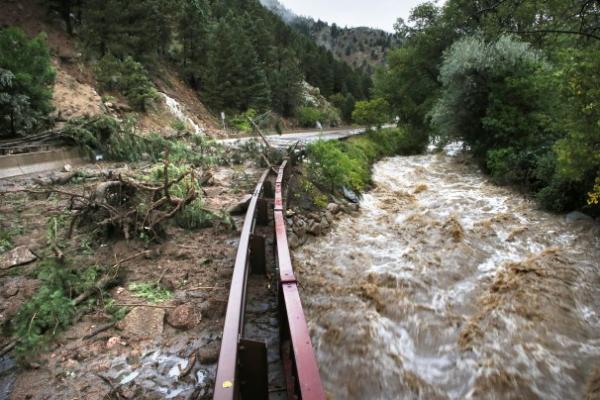
Brennan Linsley/Associated Press
The raging floodwaters of Boulder Creek, at the base of Boulder Canyon, on Friday September 13.
Source: Indian Country Today Media Network
The death toll rose to seven in the floods ravaging Colorado, among the victims American Indian Wesley Quinlan, and his girlfriend, Wiyanna Nelson, both 19.
The two were swept away by raging floodwaters on Wednesday September 11 as they tried to make it home along with two other friends, who survived. Just a week earlier the pair had vacationed with Quinlan’s mother, Glenda Aretxuloeta, to celebrate her birthday and meet her Native family members, the Denver Post reported.
“He was very, very connected to my Native American heritage,” Aretxuloeta told the newspaper, which did not give a tribal name.
As many as seven people have died in the massive floods that have been inundating Colorado since last Wednesday, including two women who are missing and presumed dead.
Boulder and Longmont, Colorado, continued to be inundated in floodwaters on September 16 as bad weather and heavy clouds grounded National Guard helicopters; more than 1,000 people awaited evacuation, and 1,000 or more were still unaccounted for, cut off because of ravaged infrastructure.
At least four people are confirmed dead, CNN reported, and two more are presumed to have perished in the raging floodwaters. Fox News said as many as seven had died.
On Saturday September 14 President Barack Obama declared Colorado a disaster area, and the Federal Emergency Management Administration (FEMA) said it was continuing to monitor the situation.
Besides the 19-year-old couple, two other victims were discovered in a roadway and a collapsed home, CNN said, while the two people presumed dead are two women, one 60 and the other 80.
With helicopters grounded, rescue crews were working on the ground only. But even they faced obstacles, with Colorado National Guardsmen among 51 people who had to be rescued on Sunday, along with first responders and civilians, when their own tactical trucks were stranded by rising floodwaters in Lyons, Colorado, Fox News said. Fifteen remained stranded after air rescues were suspended, the Colorado National Guard said in a statement.
“Mother Nature is not cooperating with us today, and currently we are not flying,” National Guard incident commander Shane Del Grosso told reporters, according to CNN. “But tomorrow if we get that window of opportunity, which is sounds like we might get, we have the horsepower to hit it hard.”
The toll is high financially as well, with Boulder County looking at a copy50 million repair bill that is 10 to 15 times its annual budget, the county’s transportation director, George Gerstle, told CNN. That’s to repair up to 150 miles of roads and as many as 30 bridges.
Besides the devastation and tragedy, the floods are troubling because they did not come from routine sources, National Geographic reported. Normally they come about from spring rains, or intense summer thunderstorms that dump voluminous rain in concentrated areas, NatGeo.com said. This was different. In just a few days, 15 or more inches of rain—more than the record high for an entire month—had fallen in the Boulder area, said Brad Udall, director of the University of Colorado, Boulder’s Getches-Wilkinson Center for Natural Resources, Energy and the Environment, to NatGeo.com.
“This was a totally new type of event,” he said, “an early fall widespread event during one of the driest months of the year.”
It may be yet another symptom of climate change, NatGeo.com noted. The drought that has gripped the Colorado River Basin for 14 years has hardened the soil, and wildfires have stripped vegetation. This leaves no place for water to go, and no fauna to halt its progress, both of which can create conditions for devastating flooding.
The Navajo Nation is currently contending with a similar situation related to drought, as parts of the reservation are recovering from flooding that also occurred last week.
RELATED: Flash Flooding on Navajo Nation Displaces Scores, Wrecks Homes With Mold and Mud
Moreover, these dynamics feed into and exacerbate one another as wildfires become more frequent on a warming planet, creating more flood-prone land, NatGeo.com said.
RELATED: Mother Earth Burning: Climate Change Will Increase Wildfire Frequency, Researchers Say
Connecting the Dots: How Climate Change Is Fueling Western Wildfires
Read more at http://indiancountrytodaymedianetwork.com/2013/09/16/native-youth-among-seven-killed-raging-colorado-floodwaters-151307
